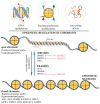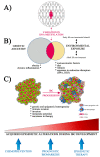Epigenetics in Inflammatory Breast Cancer: Biological Features and Therapeutic Perspectives
- PMID: 32397183
- PMCID: PMC7291154
- DOI: 10.3390/cells9051164
Epigenetics in Inflammatory Breast Cancer: Biological Features and Therapeutic Perspectives
Abstract
Evidence has emerged implicating epigenetic alterations in inflammatory breast cancer (IBC) origin and progression. IBC is a rare and rapidly progressing disease, considered the most aggressive type of breast cancer (BC). At clinical presentation, IBC is characterized by diffuse erythema, skin ridging, dermal lymphatic invasion, and peau d'orange aspect. The widespread distribution of the tumor as emboli throughout the breast and intra- and intertumor heterogeneity is associated with its poor prognosis. In this review, we highlighted studies documenting the essential roles of epigenetic mechanisms in remodeling chromatin and modulating gene expression during mammary gland differentiation and the development of IBC. Compiling evidence has emerged implicating epigenetic changes as a common denominator linking the main risk factors (socioeconomic status, environmental exposure to endocrine disruptors, racial disparities, and obesity) with IBC development. DNA methylation changes and their impact on the diagnosis, prognosis, and treatment of IBC are also described. Recent studies are focusing on the use of histone deacetylase inhibitors as promising epigenetic drugs for treating IBC. All efforts must be undertaken to unravel the epigenetic marks that drive this disease and how this knowledge could impact strategies to reduce the risk of IBC development and progression.
Keywords: DNA methylation; epigenetic therapy; histone deacetylases; histone modifications; inflammatory breast cancer.
Conflict of interest statement
The authors declare no conflict of interest. The funders had no role in the design of the study; in the collection, analyses, or interpretation of data; in the writing of the manuscript, or in the decision to publish the results.
Figures


Similar articles
-
Inflammatory breast cancer microenvironment repertoire based on DNA methylation data deconvolution reveals actionable targets to enhance the treatment efficacy.J Transl Med. 2024 Aug 5;22(1):735. doi: 10.1186/s12967-024-05553-5. J Transl Med. 2024. PMID: 39103878 Free PMC article.
-
Mesenchymal stem cells mediate the clinical phenotype of inflammatory breast cancer in a preclinical model.Breast Cancer Res. 2015 Mar 20;17(1):42. doi: 10.1186/s13058-015-0549-4. Breast Cancer Res. 2015. PMID: 25887413 Free PMC article.
-
Inflammatory Breast Cancer: a Separate Entity.Curr Oncol Rep. 2019 Aug 15;21(10):86. doi: 10.1007/s11912-019-0842-y. Curr Oncol Rep. 2019. PMID: 31414257 Review.
-
Inflammatory Breast Cancer: What to Know About This Unique, Aggressive Breast Cancer.Surg Clin North Am. 2018 Aug;98(4):787-800. doi: 10.1016/j.suc.2018.03.009. Epub 2018 May 24. Surg Clin North Am. 2018. PMID: 30005774 Review.
-
A comparison of criteria to identify inflammatory breast cancer cases from medical records and the Surveillance, Epidemiology and End Results data base, 2007-2009.Breast J. 2014 Mar-Apr;20(2):185-91. doi: 10.1111/tbj.12234. Epub 2013 Dec 26. Breast J. 2014. PMID: 24372839 Free PMC article.
Cited by
-
HER2/positive and HER2/low in inflammatory breast cancer recurrence.J Med Life. 2022 Dec;15(12):1573-1578. doi: 10.25122/jml-2022-0213. J Med Life. 2022. PMID: 36762329 Free PMC article.
-
Advances of Epigenetic Biomarkers and Epigenome Editing for Early Diagnosis in Breast Cancer.Int J Mol Sci. 2022 Aug 23;23(17):9521. doi: 10.3390/ijms23179521. Int J Mol Sci. 2022. PMID: 36076918 Free PMC article. Review.
-
Rates of Pathologic Complete Response and Overall Survival in Patients with Inflammatory Breast Cancer: A National Cancer Database Study.Ann Surg Oncol. 2024 Nov;31(12):8057-8067. doi: 10.1245/s10434-024-16026-w. Epub 2024 Aug 19. Ann Surg Oncol. 2024. PMID: 39158638
-
Nanoparticle-Based Antioxidants in Stress Signaling and Programmed Cell Death in Breast Cancer Treatment.Molecules. 2023 Jul 10;28(14):5305. doi: 10.3390/molecules28145305. Molecules. 2023. PMID: 37513179 Free PMC article. Review.
-
Prevalence and predictors of obesity-related cancers among racial/ethnic groups with metabolic syndrome.PLoS One. 2021 Apr 7;16(4):e0249188. doi: 10.1371/journal.pone.0249188. eCollection 2021. PLoS One. 2021. PMID: 33826671 Free PMC article.
References
-
- Aurit S.J., Devesa S.S., Soliman A.S., Schairer C. Inflammatory and other breast cancer incidence rate trends by estrogen receptor status in the Surveillance, Epidemiology, and End Results database (2001–2015) Breast Cancer Res. Treat. 2019;175:755–764. doi: 10.1007/s10549-019-05193-0. - DOI - PMC - PubMed
-
- Hance K.W., Anderson W.F., Devesa S.S., Young H.A., Levine P.H. Trends in inflammatory breast carcinoma incidence and survival: The Surveillance, Epidemiology, and End Results program at the National Cancer Institute. J. Natl. Cancer Inst. 2005;97:966–975. doi: 10.1093/jnci/dji172. - DOI - PMC - PubMed
-
- Dawood S., Merajver S.D., Viens P., Vermeulen P.B., Swain S.M., Buchholz T.A., Dirix L.Y., Levine P.H., Lucci A., Krishnamurthy S., et al. International expert panel on inflammatory breast cancer: Consensus statement for standardized diagnosis and treatment. Ann. Oncol. 2005;22:515–523. doi: 10.1093/annonc/mdq345. - DOI - PMC - PubMed
Publication types
MeSH terms
LinkOut - more resources
Full Text Sources
Medical

